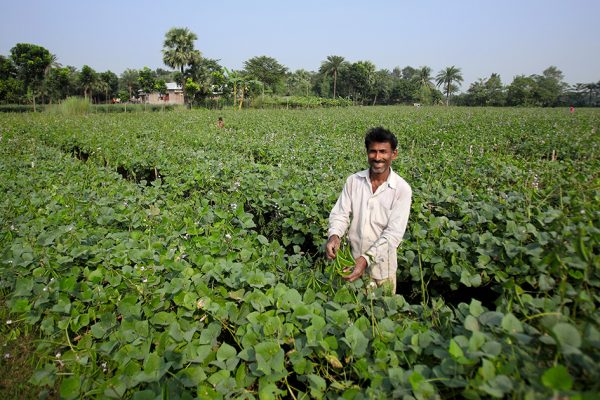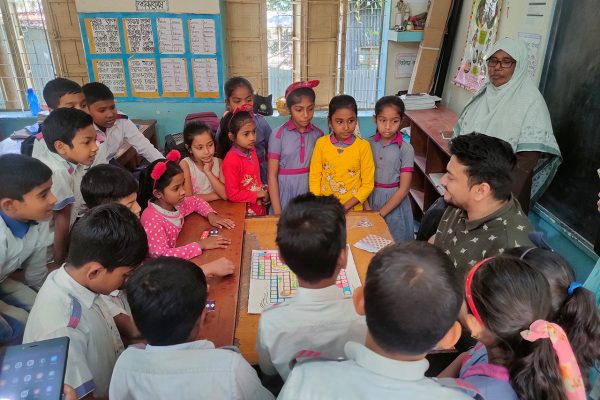Confronting marginalisation with meetings. Can it foster indigenous leadership?
Reading Time: 4 minutes
Northern Bangladesh is home to 80% of the country’s indigenous population. More than 18 languages are spoken by members of these indigenous communities upholding their rich culture, long practised heritage and colourful way of life. This diversity also lends itself as a factor in attaining universal acceptability for indigenous leaders which has historically led to a dearth of formal indigenous leaders. Can we foster local leadership by ensuring a safe platform at the community level?
“A day’s water or a day’s wage, which one would you choose?” asks Panmoni Pahan.
Panmoni lives in a small village in northern Bangladesh. The region is known geographically as the Barind tract. Groundwater tables are situated deep underground in the region which already suffers from severe surface water scarcity. Like many in her community, Panmoni now had to walk around a kilometre to the nearest village with a water source after the only tube-well in her village dried up due to over-extraction.
“Often I would return home with an empty pitcher, and be forced to use contaminated water from the ponds despite being aware of the risks, just to reach my workplace on time where we work as day labour. If I don’t make the compromise it would cost us in lost wages,” says Panmoni.
Northern Bangladesh is home to 80% of the country’s indigenous population. More than 18 languages are spoken by members of these indigenous communities upholding their rich culture, long practised heritage and colourful way of life.
Beyond the colourful exterior lies a grim situation. Over 54 indigenous groups represent only 1.00% of the total population of Bangladesh. Each community holds their own history through their culture, social structure, values and beliefs. While members of indigenous communities stay true to their roots, the socio-cultural differences such as language, lifestyle and traditions makes it challenging for them to effectively integrate themselves to the mainstream.
The situation gets more complex as the indigenous communities share a common socio-economic condition of poverty, lack of education and inadequate access to resources. The interconnection of socio-economic and socio-cultural issues weaves complex multi-layered issues that often hinders people to unite and take the leadership of their communities. It also creates issues for leaders to be universally accepted because of the underlying tribal lines of loyalties and allegiances.
BRAC is working with the indigenous communities to build bridges among different communities, creating a space for indigenous leadership to bloom at the community level. The approach’s beauty lies in its simplicity, at its core the objective is simple – foster leadership skills among people who can at least articulate their basic needs at local decision-making platforms.

Panmoni Pahan, seen standing, conducting a monthly meeting with the members of the village development organisation in her community. Photo credit: Alpona J Kujur © BRAC, 2022
Meetings as vehicles of change
Meetings are regarded as vehicles for change in the indigenous communities of Bangladesh, as it is in these spaces that local issues are discussed. This is also where decisions in regards to priorities and resource allocation are made. Representation of indigenous voices in these local level meetings is crucial for holistic development of the communities. That representation is dependent on fostering indigenous leadership.
BRAC’s Integrated Development for Indigenous Peoples of Plainlands is designed with a holistic approach to improve the socio-economic conditions of the communities and help build leadership skills. The project has formed a women-led village development organisation which ensures community mobilisation, improves access to knowledge and inspires especially women and young people to exercise leadership at different levels.
Village development organisation members create a platform in the format of a talking circle to foster indigenous leadership. members of indigenous community can raise their local problems and through discussion come up with potential solutions. These meetings create indigenous leaders. They, in turn, act as a bridge between communities and local government representatives.
These village development organisation meetings help the members prepare for the next stage which is ‘Solidarity Meetings’. Solidarity meetings are arranged at the union council, the lowest level in Bangladesh’s local government structure, with the local government representative as the chair and indigenous village development organisation members as participants. There, indigenous village development organisation members articulate the issues they are facing and present possible solutions which they came up with during the village development organisation meetings. Local government representatives are then inspired to follow through on their suggestions with investment and action.
Tale of a tube-well
After the only tube-well of their village dried up, Panmoni, who is the chairperson of her local village development organisation, and members of her community were left with two options- use dirty pond water; or make one kilometre-long commute everyday to the nearest. None of which are feasible options in the long-term.

Panmoni Pahan advocating for her community at a ‘Solidarity Meeting’ to the local government representatives. Photo credit: Alpona J Kujur © BRAC, 2022
To secure a sustainable source of clean water for her village, Panmoni and her fellow village development organisation members brought up the issue in their meetings. Then they set up a ‘Solidarity Meeting’ with the local government representative as the chair and presented the water issue and a potential solution – which was to bore a new tube-well in her village.
To garner support for their cause, they followed it up with sub-district level advocacy dialogues with the participation of indigenous leaders, local government and civil society representatives, and journalists.
But their path was beset with difficulties. COVID-19 struck and the meetings were postponed. Once again the whole community was pushed to use contaminated water. But she didn’t let it stop her, she approached the local government representative of a nearby village.
Determined to come up with a solution, Panmoni decided to approach the leader of the village development organisation of the neighbouring village to help advocate for their cause. With the consent of all village development organisation members, some selected leaders met the local government representative with an application and successfully secured a pump for their community after multiple sessions. The power of solidarity meetings was not just limited to advocating for a community tube-well. 1,600 indigenous leaders were trained over the years who ensured 5,000 people of their community could access the government’s existing social safety net services.
BRAC Integrated Development Programme works to ensure access to services for people living in hard-to-reach areas, through holistic intervention using the platform called Village Development organisation). This programme works with 1.7 million people in these areas to improve their socio economic status by creating diverse income generating opportunities and basic services to door step since 2013. The project works with around 84,000 plainland indigenous people living in poverty to improve their socio-economic conditions by creating diverse livelihood opportunities and bringing basic services to their doorsteps.
Alpona Joyontee Kujur is a Senior Officer-Communication and Documentation at BRAC’s Integrated Development programme.
Sonali Chakma is a Communications Specialist at the Communications Department at BRAC.





